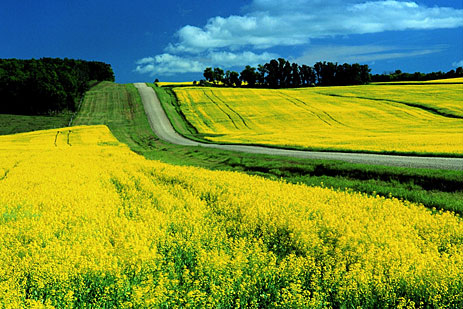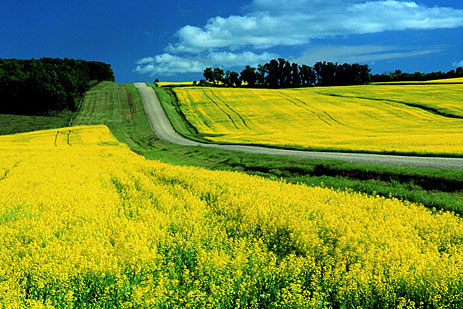 Canola and other crops don’t always grow within the lines. Photo: Pioneer Hi-Bred SeedsOne of the primary concerns with transgenic (aka genetically modified) crops is the risk of genetic contamination, i.e. the transfer of engineered genes to wild versions of the same plant. The corporations involved in genetic engineering, such as Monsanto and Bayer CropScience, have time and again assured regulators and the public that this risk is minimal. Still, the government mandates “buffer zones” around such crops’ plantings and the corporations who sell the seeds have created their own protocols to ensure this kind of thing never happens.
Canola and other crops don’t always grow within the lines. Photo: Pioneer Hi-Bred SeedsOne of the primary concerns with transgenic (aka genetically modified) crops is the risk of genetic contamination, i.e. the transfer of engineered genes to wild versions of the same plant. The corporations involved in genetic engineering, such as Monsanto and Bayer CropScience, have time and again assured regulators and the public that this risk is minimal. Still, the government mandates “buffer zones” around such crops’ plantings and the corporations who sell the seeds have created their own protocols to ensure this kind of thing never happens.
Well, surprise! It’s happened. Big time.
Scientists from the University of Arkansas announced at the Ecological Society of America annual meeting the results of a study that showed genetically engineered pesticide-resistant canola growing like a weed in North Dakota. They found that up to 80 percent of wild canola in their sample from various North Dakota roadsides contained genes that conferred resistance to either glyphosate (the active ingredient in Monsanto’s RoundUp Ready pesticide) or gluphosinate (from Bayer’s LibertyLink seeds).
But it gets better, er, worse. The scientists also found wild canola with both properties. And as lead scientist Cynthia Sagers observed in an accompanying news report, “these feral populations of canola have been part of the landscape for several generations” — plant generations, mind you, not human generations. Still, this is not a new phenomenon. It’s true that biotech companies do sell seeds with multiple forms of pesticide resistance, so-called “stacked trait” seeds. But these wild canola plants managed this interbreeding feat all by their lonesome.
So, these genetically engineered plants — which, when out in the wild, are considered weeds — are cross-pollinating and transferring “alien” genes that confer pesticide resistance. The next step in the chain is for the canola to interbreed with other related weeds. Suddenly, the prospect of our nation’s bread basket infested with superweeds becomes very, very real.
Monsanto issued a statement that didn’t exactly address the issue at hand:
Tom Nickson, head of environmental policy at Monsanto in St Louis, Missouri, told Nature, “Those familiar with canola know that these plants are readily found on roadsides and in areas near farmers’ fields. This was true prior to the introduction of GM canola, and a common source is seed that has scattered during harvest and fallen off a truck during transport.”
Okay. No one is accusing Monsanto of culpability in the scourge of roadside canola. It’s the utter failure of the company’s safety protocols that’s the issue. Time and time again, Monsanto and its ilk have promised that this sort of thing would never happen; that the systems in place to prevent it are foolproof. Well, I think we know now who the fools are …
A report last year suggested that farmers routinely ignore planting requirements and buffer zones when it comes to genetically engineered crops. And now we see the result. Perhaps this news will give the USDA pause as it considers whether to allow Monsanto’s GM alfalfa to be planted this spring, which was recently halted by a federal judge for insufficient protections against exactly this kind of phenomenon.
Either way, what we’re seeing is what some would have considered a worst-case scenario a few years ago — transgenic plants growing in the wild and creating versions that don’t currently exist, even in a lab. Scared yet?



